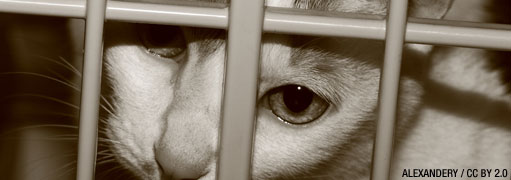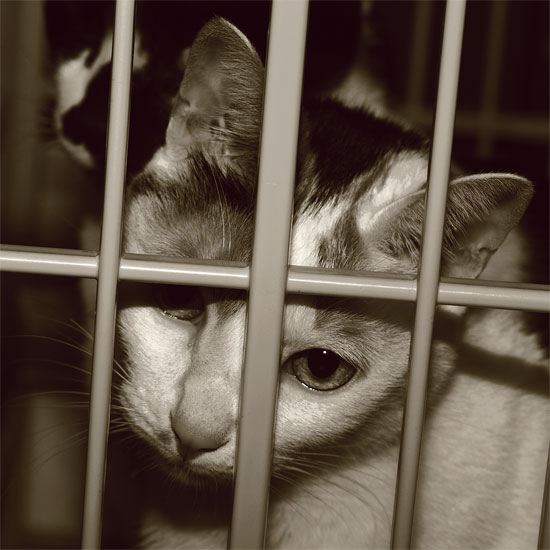When the days grow longer, female cats go into heat, triggered by the extra light. By summer, scores of kittens are born to feral mothers in shaded pockets and protected coves of the city. They struggle to survive and, if they make it, will likely become part of colonies spreading throughout town. It’s an urban problem. Cats are left behind as houses and apartments change hands. The domesticated animals are forced to fend for themselves. These former pets breed, and their offspring may never set foot in a home. Instead, they grow up wild.Fully grown feral cats—different than once-socialized stray cats—are not animals that simply need affection to curb their uncivilized behavior. They’re not human-friendly and can’t become house pets. Albuquerque’s fair climate is generous, providing year-round living and good conditions for procreation. This presents the city with a problem: What to do with an immeasurable number of feral felines?The shelters used to euthanize them. "Trapping and killing them hasn’t worked," says Barbara Bruin, director of the Animal Welfare Department. "We have killed hundreds of thousands of feral cats, and there are still as many as there ever was—or more." Fix and Release On Easter Sunday, dozens of volunteers unloaded vehicles full of cat carriers, crates and traps—anything that could be used to transport a small wild animal. Cats yowled and mewed in an unceasing chorus. They smashed themselves into the far ends of their cages, contorting their bodies, hissing. Crates lined a hallway outside of the Animal Humane clinic, a facility that’s on loan once a month for mass spaying and neutering. Focused on their mission, the volunteers scarcely registered the holiday. The cats were evaluated. Those in bad shape would have to be euthanized—an animal that’s too sick or injured is unlikely to survive the surgery. The others were given anesthesia and then cleaned, the matted fur cut away, the small wounds tended. Several were placed on tables in an operating room. A volunteer veterinarian performed the procedures as quickly as possible. "This one’s pregnant," the doctor said to her assistants as she worked. "This one’s going to need more gas. He’s waking up." Males take between one and two minutes, and females take between eight and 10. Pregnancies are terminated. "The key is to make a small incision," explained Jayne Sage, a volunteer with New Mexico Animal Friends, as she looked on. "It takes less time to stitch them up. The less time they’re opened up, the safer it is for them." The cats, while still anesthetized, have the tips of their left ears clipped so they can be identified in the future. Volunteers apply a gel that stops the bleeding, and the animals are closely observed. "If you lose cats, it’s in recovery," Sage said. Before they wake, they receive vaccinations and a shot of penicillin. Then volunteers take them home overnight, and the next day they’re released back onto city streets.This is one of Albuquerque’s trap-neuter-return operations. The premise of TNR is that if you kill a cat, its place in the colony is swiftly taken by another that will use its food sources and, left unfixed, continue to breed. If you return a sterilized animal, it will resume its life without giving birth to more hungry kittens. The population should slowly diminish. "TNR is less than perfect," said volunteer Alek Dewispeleare, as she peered into carriers to keep an eye on resting cats recovering from surgery. "But it’s hard to say they’re better off dead."Animal Friends spayed and neutered 56 cats that day. Albuquerque pays the nonprofit up to $55,000 to do this work. A national group, Best Friends Animal Society, also signed a contract at the beginning of the year to fix and release 3,5000 cats, but the project should incur no cost to the city. TNR has become the city’s method for handling its feral population—but not everyone is confident in the plan. Unethical and Inhumane? Veterinarian Janet Kramer started work at the city animal shelter in 2007. Last year, she made a number of complaints about the TNR program, as well as other practices at the shelter. The tipped ears of the cats don’t prevent the same animals from being brought in more than once, she says, and some of the tip-eared cats don’t appear feral. “So there’s not a good procedure to determine whether they’re friendly or not.” And because cats are simply returned to their home colonies, frustrated neighbors sometimes resort to cruel measures. Kramer displays a startling case file on a cat with a tipped ear that was impaled by rebar in February as evidence. Among her concerns is that the cats are not disease tested, which means they may be released back into neighborhoods to die slowly of their illnesses. This, she says, is unethical and inhumane: Ailing felines may pass their diseases to others—pets and feral cats alike. Disease testing is not the national standard, said volunteer Dewispeleare on Easter. Euthanizing a sick cat doesn’t remove disease from a colony, she added. Ultimately, testing is too expensive. That’s the long and short of what Janice Dankert, a coordinator for Best Friends, told Kramer in a March email.Kramer made complaints to her boss, shelter Director Bruin. Kramer’s concerns were not adequately addressed, she says, so she met with with a city administrator, Chief Operations Officer John Soladay. A week later, on March 1, she was fired, which she says is the direct result of her meeting with Soladay. Bruin and Soladay say they cannot comment on personnel matters. Kramer has not filed a lawsuit and hasn’t decided whether she will. The TNR program, she says, is aimed at decreasing kill numbers at the shelters, which it does without thought to quality of life. "We are releasing hundreds of feral cats back out to the neighborhoods from where they were received with no regard for public health or any determination whether or not this is a humane practice." Chances TNR is part of an overall effort to clean up the shelters’ appearance, Kramer says, but attempting a no-kill policy at a crowded, large municipal shelter isn’t always in the best interests of homeless animals. Albuquerque’s shelters aim to help healthy creatures that don’t have behavioral issues, says Bruin, who’s been the director there since December 2009. She was ushered in with the Berry administration and took over a troubled Animal Welfare Department that had to euthanize 42 percent of its intake. Last year, that dropped to 28 percent. A beefed-up foster program has aided in the mission to find animals homes, and so has improved facilities for adopters to view and hang out with potential pets. Some cats and dogs have been in the shelter awhile, she says, but the staff doesn’t give up on them. This is a problem, too, says Kramer, because when the shelter’s full, it’s hard to quarantine diseased animals. Bruin says that hasn’t been an issue, though. "We’ve managed to keep ahead of that," she says. "There’s been no great outbreaks." Bruin acknowledges that city shelters are sometimes more full than is ideal but says she can’t control the intake. Last year, Animal Welfare took in more than 25,000 animals from all corners of Bernalillo County. The last few months have seen a boom in population, too, with more than 2,300 coming through the doors in May. "Basically, if an animal comes in that appears adoptable, we’ll give it a chance."
Residents can help slow the rise of feral colonies by having their pets fixed, says Jayne Sage of New Mexico Animal Friends. She also recommends that if you start feeding feral cats, you should have them spayed or neutered. "Don't wait until there's kittens."If you meet low-income requirements, take your animal to the shelter for free or low-cost sterilization:cabq.gov/pets/spay-neuterAnimal Humane New Mexico also offers low-income spay and neuter services:bit.ly/HumaneSpay





